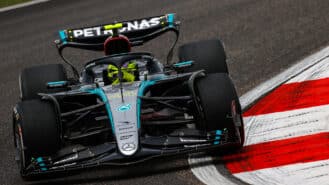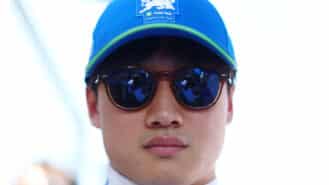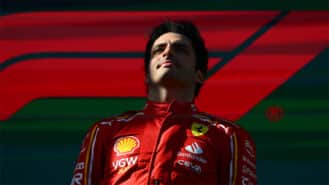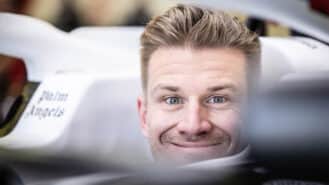
Hamilton moans earn him F1 highlights reel – Up/Down in China
The king of positive vibes has seen his crown slipping recently – a grey day in China only deepened the Silver Arrows' Slough of Despond
Having talked my way past the reception desk at the Dean Street Townhouse I wander through the half-full restaurant looking out for ex-Stig and GT driver Ben Collins.
He’s tucked away near the back, already scanning the breakfast menu and is flanked by three or four tables full of people who no doubt didn’t even give him a second glance when he arrived.
It’s an odd situation – for eight years Collins was one of the most famous ‘faces’ on TV, but without that white race suit and helmet he can wander around London with 99 per cent of the public having no idea he was The Stig from Top Gear.

As the race-suited driver he met Cameron Diaz, Tom Cruise, Hugh Jackman and countless other celebrities, but they probably wouldn’t know him if they met him now. “For me it was just like wearing a pair of sunglasses,” he comments when we’re chatting about teaching the stars in a reasonably priced car on Top Gear.
Having sent in his CV to the show’s producer, Andy Wilman, he was asked to come down to Dunsfold Aerodrome where he was given a Focus RS and told to post some lap times. Three months later he was hired as the ‘new’ Stig (the old one, Motor Sport contributor Perry McCarthy, was unceremoniously thrown off an aircraft carrier. Don’t worry Pel, we won’t do that to you.)
When he first started only two people – Wilman and a fellow producer – knew who he was. He’d even go to the lengths of putting a balaclava on before arriving at work and then disappearing to get changed. Six months after starting he was sat, as Ben Collins, in a motorhome on the set and in walked Jeremy Clarkson. “He looked at me and asked ‘what are you doing in my motorhome?’ I hadn’t actually met him so he had no idea who I was. One of the guys said ‘don’t worry, that’s Ben, he’s working for us’. That was it. Initially he had no idea.”
Despite the apparently acrimonious split he speaks fondly of his time on the TV show and even though he was eventually revealed as The Stig to the wider world, he knew it was time to go and try something else before that happened. In 2008 the then BBC Magazines-published (!) Radio Times ran a story on who it thought the Stig was. The top three options were stunt driver Russ Swift (who doesn’t race), Damon Hill (umm) and Collins.

F3 at Zandvoort, 2000
By this time, though, Collins had already immersed himself in the world of stunt driving – a career move which kicked off with having to drive Nicholas Cage into a bus. “I was driving the car from the roof,” he explains, “and Nicholas was sat underneath in the driver’s seat. I thought they’d take him out… Anyway, being in a pod on top of the car meant straight away that you have less control because of the hydraulic steering. They did say ‘there’s some serious money in that car, don’t hurt him. You do have to give the bus a bit of a slap, though, so that it looks real.’ It was a lot of fun.”
Work on Batman and Bond followed and after seeing me he was off to Pinewood to get “kitted out” for his work on the next instalment of Bond: Spectre. However, his focus this year is on proper racing. It’s where he started aged 19 in 1994 and despite his forays into TV and film it’s where he’s returned.
“I got my race licence when I was 18,” he says after we’ve ordered coffee and breakfast, “and I started racing when I was 19. I managed to put myself third on the grid for my first ever race [in Formula First] amongst all these karting champions. I was as surprised as they were; I literally had no idea what I was doing. Off I went and in the first season I wrote off three cars because I had absolutely no fear, no comprehension of what was physically possible or impossible. I had watched my Ayrton Senna and Gilles Villeneuve videos… how else do you learn?”
Thankfully he realised that the crashes needed to stop and in Formula Vauxhall Junior in 1995 he finished the season intact with eight podiums and two wins at Knockhill and Silverstone. He also did the 1995 Formula Opel Winter Series and finished second in the standings behind Marc Hynes. “It was my Dad that got me into it,” he says of his racing as the waitress arrives with his duck egg and ham hock and my eggs Benedict. “It was all through him, but you never listen to your parents do you? I read some books and thought I knew it all. I had heard of Formula 1 and that’s where I wanted to go.”

In the Ascari at Donington, 2001
He made the step up to Formula 3 and it was there that his engineer told him to try sports cars. “All I thought was ‘that sounds as though it’s for really old gits, it sounds awful’. The best car I’ve ever driven, though, bar none, was the 2001 Ascari A410-Judd. It was a Lola chassis with a V10 F1 engine in the back and the 800bhp meant you could spin the wheels in third in the dry. Amazing.
“There was no power steering and after three laps it was like doing rounds with Mike Tyson. There was just nothing left in your arms. My team-mate then was Werner Lupberger and he was built like Rocky Balboa. I sat there thinking ‘it must be vanity to be that big because we’re all skinny little snakes in F3’. It wasn’t – you had to be that big to manhandle the car.”
Despite not wanting to race sports cars Collins realised how much fun they could be and after his first trip to Le Mans in 2001 he emerged converted. “It was amazing to be there and on the pace,” he comments. His racing, since the TV and film side of his life took off, has taken second place. “I got into the stunt driving because it was just after the financial meltdown and there wasn’t much out there for a professional racing driver. My drive with RML, which I thought was looking really good, just ended in 2011. I went and did some filming and the following year (2012/13) I had a drive lined up and it fell through in March. There were very few drives out there and it’s easy to drop off people’s radar.
Last year he spent his race days at the wheel of RAM Racing’s Ferrari 458. The British-based squad, having fallen into financial difficulty, then made the introductions so that he could move to Krohn Racing for Le Mans where he was on the pace – “I did think ‘thank God for that’” – until the car suffered gearbox problems. On February 8 he’ll be doing the Bathurst 12 Hours with Australian GT team Maranello Motorsports in a McDonalds-sponsored 458 and then hopefully competing in the WEC full time.

Much of his past year, though, has been focused on his new book: How to Drive. Having already written the 2011 Sunday Times bestseller (The Man in the White Suit) it wasn’t completely unchartered territory. This time, however, the subject is much more general – it’s for every driver on the road.
Aside from the inadequacies in the standard driving test, Collins was tempted into putting pen to paper by his experience with the police. This wasn’t at a roadside having been caught speeding, but having taught some of the force’s drivers. “I love the police and have a lot of time for them,” he’s quick to mention, “but I met a lot of very arrogant instructors who had no idea what they were doing. Their skills were crap in terms of controlling the car at high speed and they wouldn’t accept what they were doing was wrong.
“First of all I was gobsmacked that they did their high-speed training on the road. I soon discovered that a number of them actually died while doing the course. I went out with them and analysed what they were teaching to younger officers – steering technique, the line you take through a corner, etc. and there were things that immediately stood out. One was the line through the corner and they prioritised vision over what you and I would call a racing line. The latter is the most stable one and that’s not down to the car, it’s down to the tyres – the tyres want to take the easiest route. They were fine through left-hand corners, but in right-handers they were staying out wide where all the dirt and marbles were. They also always used the ‘push and pull’ steering technique where you shuffle the wheel through your hands. If you didn’t use that you actually failed the police test! They also weren’t allowed to use engine braking.”

The 1934 Road Traffic Act introduced the first compulsory driving test for everyone and the driving methods were partially shaped by racing driver Lord Cottenham. “In those days the steering wheels were so big that you had to use the ‘push and pull’ method and you couldn’t use engine braking because of having to double-declutch,” Collins points out. Partly thanks to his input things are changing and for any police officers who are still suspicious of engine braking, the force is moving to automatics which will mean they can’t not use it…
It’s an interesting niche for a book and as Collins rightly points out, young drivers aren’t going to go out and buy DVLA guides after passing their test. If they are going to read anything about driving it needs to be easily digestible with key bits of information interspersed with stories from film sets and the Top Gear test track – “I’m not sure it gets any drier than explaining how to change gear,” he quips while describing the struggles of writing the book. “I spent at least a week trying to work out how I make this come off the page without boring the crap out of everyone, including me.”
As part of the research Collins spent days buried in libraries and the internet looking at crash statistics in order to understand how they might have been manipulated (which a lot of them are). The time spent on research has paid off, though, and however good you think you are at driving on the road there’ll be stuff in there that you don’t know. “I think,” he says as we’re paying the bill, “that next time I do a book it’ll be for kids or a work of fiction…”
As we leave the Dean Street Townhouse we wander past my clapped-out, scruffy scooter, which Collins finds particularly amusing. So much so he insists on getting a photo of me stood next to it. Despite being an ex-Stig, a stunt driver and professional racing driver Collins is a normal bloke who simply loves cars and all the science that goes behind driving them. And we like people like that at Motor Sport.

The king of positive vibes has seen his crown slipping recently – a grey day in China only deepened the Silver Arrows' Slough of Despond

In the face of soul-destroying boredom, only one driver can bring the entertainment needed to rescue a sport which resembles a broken AI tribute to itself

Waking up at 4am on a Sunday is rarely worth it, especially when Max Verstappen looks poised to take another lights out to chequered flag victory — as he did…

Should there be a new prize for a team finishing sixth in the championship – just like the Jim Clark Trophy in the good old turbo times?